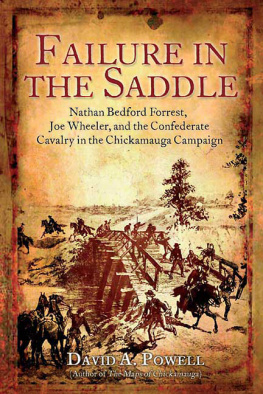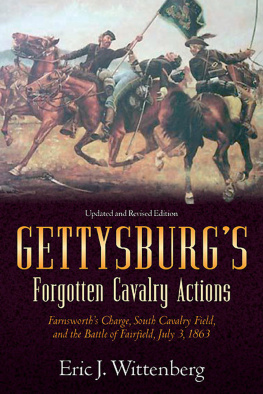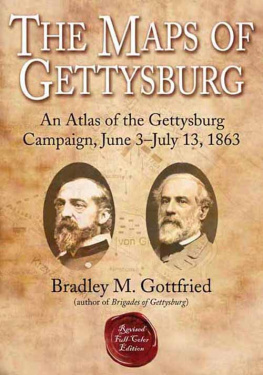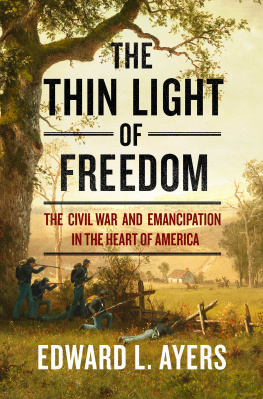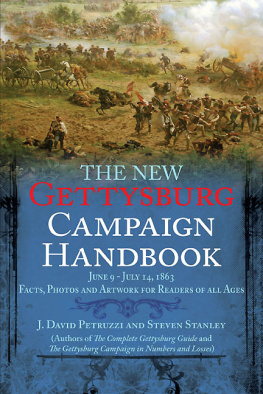T ULLAHOMA
The Forgotten Campaign that Changed the Course of the Civil War,
June 23 July 4, 1863
David A. Powell
and
Eric J. Wittenberg

Savas Beatie
California

2020 by David A. Powell and Eric J. Wittenberg
All rights reserved. No part of this publication may be reproduced, stored in a retrieval system, or transmitted, in any form or by any means, electronic, mechanical, photocopying, recording, or otherwise, without the prior written permission of the publisher.
Library of Congress Cataloging-in-Publication Data
Names: Powell, David A. (David Alan), 1961 - author. | Wittenberg, Eric J., 1961 - author.
Title: Tullahoma: The Forgotten Campaign that Changed the Civil War, June 23 - July 4, 1863 by David A. Powell, Eric J. Wittenberg.
Other titles: Forgotten Campaign that Changed the Civil War, June 23 - July 4, 1863 Description: California: Savas Beatie, [2020] | Includes bibliographical references and index. |
Summary: Tullahoma: The Forgotten Campaign that Changed the Civil War, June 23 - July 4, 1863 is the first detailed tactical examination of Union General William S. Rosecranss masterful effort to outflank the Confederate Army out of their strong defensive positions in Middle Tennessee. Largely eclipsed by the bloodier and more dramatic Vicksburg and Gettysburg campaigns, Tullahoma has long been overlooked, until now. This work examines the preconditions, execution, and outcome of the campaign. Provided by publisher.
Identifiers: LCCN 2020007895 | ISBN 9781611215045 (hardcover) | ISBN 9781611215052 (ebook)
Subjects: LCSH: Tullahoma Campaign, 1863. | Rosecrans, William S. (William Starke), 1819-1898
Military leadership. | Tennessee, MiddleHistory, Military
19th century. | United StatesHistoryCivil War, 1861-1865Campaigns. | Tactics.
Classification: LCC E475.16 .P69 2020 | DDC 973.7/34dc23
LC record available at https://lccn.loc.gov/2020007895
First edition, first printing

Savas Beatie LLC
989 Governor Drive, Suite 102
El Dorado Hills, CA 95762
Phone: 916-941-6896 / (E-mail)
www.savasbeatie.com
Savas Beatie titles are available at special discounts for bulk purchases in the United States. Contact us for more details.
Eric Wittenberg dedication:
To my wife and best friend, Susan Skilken Wittenberg,
without whose unflinching support, none of what I do would be possible.
Dave Powell dedication:
To my wife, Anne Powell, who has been such a tremendous help in all my endeavors, and to my father, William
D. Powell, who first instilled in me my love of history.
Table of Contents
List of Maps
1. Theater Mapfrontis
2. Cavalry Actions in the Spring of 1863
3. Movements of June 23
4. The Fight at Liberty Gap
5. Movements to Hoovers Gap
6. The Battle of Hoovers Gap
7. Movements of the XXI Corps to Manchester, June 24-27
8. The Defenses of Shelbyville
9. The Fight at Guys Gap
10. The Battle of Shelbyville
11. The Retreat from Shelbyville
12. Wilders Decherd Raid
13. The Defenses of Tullahoma
14. The Union Advance on Tullahoma
15. Braggs Retreat from Tullahoma to the Tennessee River
16. Rosecranss Pursuit
Maps have been placed throughout the book for the convenience of the reader.
T ULLAHOMA
Acknowledgments
Eric is grateful to Greg Biggs for his invaluable assistance with this project, including his bugging Eric for years to tackle the Battle of Shelbyville, for generously sharing his years of research, and his time in visiting sites associated with the campaign. He is also grateful to Phil Spaugy for providing his Battle Wagon for a visit to the many sites associated with the Tullahoma Campaign. Chris Kolakowski reviewed our manuscript for accuracy and readability, and we appreciate that a great deal. Eric also appreciates the fact that Dave was willing to work with him on a large project which is not within his normal area of expertise. Eric appreciates the good work done by Theodore P. Savas, managing director of Savas Beatie, LLC, our publisher, and his talented staff who do such a good job of producing and marketing handsome books. Finally, and as always, Eric is grateful to his much loved and long suffering wife, Susan Skilken Wittenberg, without whose support none of this would be possible.
Dave is, as ever, thankful for the legion of supporters who stand behind every book. Tullahoma is no exception. He would like to thank Greg Biggs, a longtime student of the Civil War in Tennessee. Greg generously shared the many resources and materials he has collected on Tullahoma, as well as helping lay out the driving tour that supplements this work. In a similar vein, Dave wishes to thank Dr. Michael Bradley, whos own work on Tullahoma (in his back yard, so to speak) was important to helping us understand the campaign. Phil Spaugy proved to be an excellent driver, and wonderful road companion. Dr. Chris Kolakowskis comments on a draft of this work provided important insights, as did Sam Davis Elliott, who also reviewed this manuscript. Sam saved us from a couple of particularly embarrassing errors concerning the Bishop Polk, for which we are indebted.
The staff at Stones River National Battlefield were also helpful, especially Ranger Jim Lewis. Tullahoma lacks any of the significant protections other fields enjoy, meaning that Stones River, in Murfreesboro, has become the Tullahoma Campaigns park by default. The park has collected significant holdings of material related to the campaign, to which Jim provided easy access as needed.
Thank you, Eric, for proposing the project and joining forces. This long-awaited partnership has been extremely rewarding.
My friend David A. Friedrichs produced the wonderful maps, as he has for several of my books. He knows how much I appreciate his help.
Finally, thanks must go to Theodore P. Savas for extending the opportunity to write this book, all the staff at Savas Beatie for all they do, and Joel Manuel for giving it a final proof. Tullahoma has long needed a full- length study, and Dave is eternally grateful Savas Beatie continues to welcome and support his work.
Prologue
Sandwiched into Obscurity
The first week of July 1863 saw a cascade of triumphant news delivered to a war-weary Northern populace. Thus far the American Civil War, now more than two years old, had seemed to produce nothing but stalemate and endless casualty lists. On July 4, however, dramatic headlines splashed across the nation trumpeted the Union success at Gettysburg, Pennsylvania, where Maj. Gen. George Gordon Meades Army of the Potomac had beaten and turned back Confederate Gen. Robert E. Lees hitherto unstoppable Army of Northern Virginia. More details flooded forth during the next few days making it clear that the defeated Rebels were indeed retreating.
Next page

